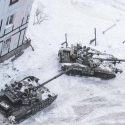ESTABLISHING AN EUROPEAN ARMY: Even if prudent, there will be no European army any time soon

Concerns are growing in many European countries that they can no longer depend on the United States and the security guarantees enshrined in Article 5 of the NATO treaty. President Trump’s decision to withdraw US forces from Syria marked the end of US reliability. Doubts about America’s trustworthiness have produced a flurry of driveling speeches in 2018 on the idea of a European army. So – what about it?
It is an old idea, which failed first in 1954 when the French National Assembly refused to ratify the European Defence Union treaty. It has since resurfaced from time to time but was never agreed upon and implemented. Will it fare better now, five years after the wake-up call produced by Russia’s illegal seizure of the Crimea from Ukraine?
Quite a few initiatives have been launched in recent years. Twentyfive EU members agreed on establishing the Permanent Structured Cooperation (PESCO). Its tiny steps towards building common force components compelled some to rekindle dreams of a European Defense Union. Within NATO, a similar German initiative was agreed upon: the NATO Framework Concept (NFC). Other political ideas have popped up, such as the creation of a European Security Council, the establishment of a Defense Committee of the European Parliament and the suggestion – a ridiculous one considering its legal impossibility – that France renounce its permanent membership in the UN Security Council and hand it over to the EU. While all were well-intended, there is simply no coherent political will to establish a common defense of Europe, to accept majority decisions or to transfer the defense portion of national sovereignty to a supranational organization – even a European one.
At any rate, such a body would have to be more inclusive than the EU. Defending Europe is politically impossible without the inclusion of the United Kingdom, Norway, Iceland and even Turkey. And in terms of geostrategy, it is not feasible without control of the North Atlantic and adjacent parts of the Arctic Ocean.
As long as this reality persists, there will be no meaningful European Security and Defense Strategy leading to command and control arrangements, to joint operational concepts and to a common and, above all, comprehensive planning process encompassing all political and diplomatic tools: economic instruments, police capacities, security and disaster relief elements and military forces that can operate throughout Europe and its periphery on land, in the air, at sea, in outer space and in cyberspace.
None of the steps taken so far make much of a difference. The sad European reality will thus continue. Our armies will comprise 17 different tanks, 26 different howitzers, 20 different combat aircraft and 29 different frigates or destroyers. Europe’s defense budgets combined total approximately 50 percent of the US budget, while the military manpower of the Europeans is close to 50 percent greater than that of the US, yet the combat power of the Europeans is at best 20 percent of what the US armed forces can marshal.
Moreover, a unanimous decision on the use of European military power is rather unlikely; if such a decision were made, the command arrangements would be patchy at best. The EU Battlegroups established in 2004 is a telling example: They never saw action.
Looking at these sobering realities and at the multifaceted risks and dangers in the years ahead, there can be but one conclusion: Europe must improve its capabilities to protect and defend itself. To this end, the pledge to reach the goal of spending 2 percent of our nations’ GDP on defense must be met.
What matters even more, however, is the real output. Demanding a European army now is putting the cart before the horse. Without two politically crucial prerequisites, there is not the slightest chance of making it a reality. The first is the political resolve to use military force as the ultimate instrument of politics; the second is agreement on a set of missions geared to the threats of today and tomorrow. The legal basis and rules of engagement must be agreed upon politically as well. Foreseeably, questions such as the potential area of employment and common funding of both equipment and operations will trigger divisive debates.
The transfer of authority to a European entity is a tricky problem. Could a European army only react to an attack on any of the EU members or would the presumption of an imminent attack suffice to trigger preventive action? These are by no means all the questions that need to be answered politically, but they indicate the intractability of the issues to be cleared before one can start planning a European army.
Beginning such a political process now, and were it by a core group, would be most desirable. But the complex nature of the issues suggests that there will be no such force any time soon. At best, we would get more empty shells such as an “army of the Europeans.” The truly pressing question is therefore what to do in order to meet the urgent requirement of improving European defense now.
I could imagine that agreement could be won for a bottom-up approach. It would aim at force multiplying and enabling European component forces to be fully interoperable, identically equipped and able to cooperate with forces of non-EU NATO nations. They should be capable of operating under EU command while prepared and equipped to join up with units of other NATO nations, thus forming a NATO component force. This would kill two birds with one stone. The EU could act if and where it must defend its interests without US involvement, but it could also place these components under NATO command if and where NATO must act under Article 5 as well as Article 4.
Furthermore, this would strengthen both NATO and the EU. The justified American demand that the Europeans contribute more would be met, while the strategic indispensability of preserving the defense of the wider NATO treaty area as the sole responsibility of the Atlantic alliance would remain unchanged. At the same time, the US would no longer be the policeman for Europe, yet it would remain committed to serving its own national interest to protect its opposite Atlantic coastline.
In addition to the emerging European airlift capability featuring air-to-air refueling capacity, such component forces should include a sea transport capability, as close to 80 percent of our world’s hypothetical crisis areas are within 200 kilometers from a shore. An EU heavy transport helicopter component could help in disaster relief as well as in interventions. It goes without saying that satellite reconnaissance along with medium altitude ground surveillance and mobile missile defense should round out the EU components. They could be tailored in such a way as to supplement respective NATO capabilities yet simultaneously enable the EU to operate independently within its area of interest.
Last but by no means least, one must think about nuclear weapons, ultimately the decisive tool in preserving peace, as arms control alone can never succeed in doing so. France, after Brexit the only EU country with a nuclear arsenal, will never renounce its weapons or share them with the EU. But there are six European NATO countries, five of them in the EU, that already operate nuclear-capable aircraft. One could thus imagine a European nuclear strike force to be manned, equipped and financed by these six NATO members. Could there be a better solution than two multinational wings of dual-capability aircraft comprising six national squadrons flying the American F-35?
Cyber, artificial intelligence, nanotechnology and robots may offer further options for EU component forces. More pressing, however, is the need, over time, to modernize and thus harmonize the equipment of the traditional land, air and naval forces. Europe should aim at standardized armaments programs. For this reason, it must strive for greatly improved industrial cooperation.
Mentioning the many obstacles on the long and bumpy road to meaningful European defense improvements does not mean that the process should not begin forthwith. Our politicians must develop the idea of a Europe that protects, “une Europe qui protège.” Defense and security could thus become the core of a new vision for Europe, which could one day lead to the reality of a European army.
KLAUS NAUMANN
is a retired German general who served as chief of defense of the Bundeswehr from 1991 to 1996 and as chairman of the NATO Military Committee from 1996 to 1999.




